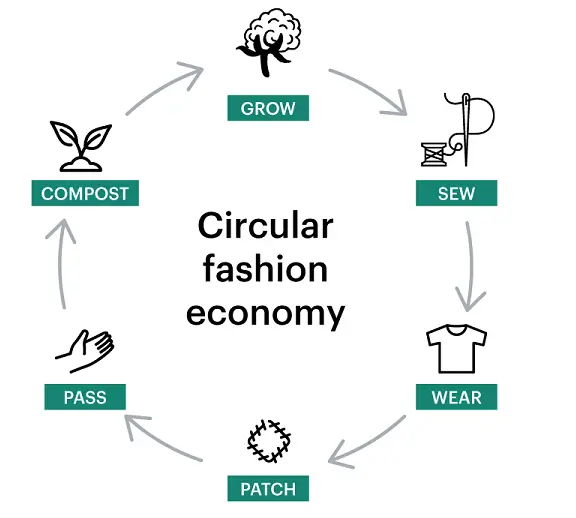What is Circular Fashion | Advantages and Disadvantages of Circular Fashion
Any fashion industry plays a globally famous and demanding role those have the business globally. Fashion-related organizations can attract people very easily, so these organizations are influential. Even the fashion industry is considered one of the most polluting companies globally. Moreover, it has a negative impact on the natural environment. So today, we will learn about What circular fashion is and its Advantages and Disadvantages.
What is Circular Fashion?
It is a system or process by which our garments and personal accessories are constantly produced with special consideration. In other words, circular fashion is the effort to make things last longer, made of environment-friendly materils. It is the opposite process of Fast Fashion. Moreover, circular fashion oversees the entire product life cycle, from product sourcing, manufacturing, design, storage location, available transportation, marketing, sales, and reaching the consumer.
What are the primary purposes of Circular Fashion?
- It manufactures individual goods in making individual enhanced products reusable through the use of fewer materials.
- Collecting non-recyclable and polluting products from suppliers and arranging their removal as soon as possible.
- Making useful by adding and removing unwanted and unusable products.
- It Presents new products by changing the internal and external aspects of old products.
- The fashion world includes shoes, clothing, etc., according to new trends and constantly encourages the safe, sustainable,, and ethical production of all kinds of products.

What are the principles of circular fashion?
It manages the organization in a very simple way. So their business policies are formulated that way. So that waste is reduced, and products can be made reusable through recycling. As a result, financial complications in business are also less. Principles of Circular Fashion:
- Circular fashion-related companies carry product resale systems.
- After purchasing their product, if the buyer finds any problem or defect in the product, it provides an exchange.
- Keeps take & back skim running in stores.
- If necessary, the organization does upcycle.
- In terms of cloth material, it is necessary to use safe and unadulterated materials.
- The fiber used must be renewable.
What are the steps in the circular fashion process?
Any business organization has its own strategy or process in managing the organization. By which it is decided when and how to do a task. Their work is gradually implemented around a fixed system. Circular fashions also adopt various step-by-step processes to carry out their functions. The steps are:
- ✔Planning for the fashion industry.
- ✔Identify the constraints the manufacturing industry may face.
- ✔Assessment of upcoming industry risks.
- ✔Formulate solutions to address risks.
- ✔Production of sufficient quantity of goods.
- ✔Creating attractive designs for industry and
- ✔Arrange transportation and distribution.
What role does circular fashion play in Textiles?
In the case of circular fashion textiles, it analyzes the energy sources of the current fabric material and looks for alternatives due to limited resources. It even keeps the textile system up to date, brings a sense of innovation in design, and stays ahead in using new technology. Even in textile manufacturing, waste can be observed at various places around the establishment. However, circular fashion uses very little waste in textile manufacturing, reducing waste in the textile industry. It reduces the negative effects of textiles.
Advantages of Circular Fashion
- Circular Fashion makes clothes in a safe and non-toxic way.
- Prevents extra wastage in production.
- It adopts some techniques by which the used cloth is re-converted into new cloth.
- Efficient in using safe materials or high-quality fibers.
- Circular Fashion provides sustainable and superior quality fabrics and materials to the market.
- Reduces misuse of national resources of the country.
- Reduces negative impact on the natural environment.
- Makes the global raw material supply chain more secure.
- Encourages innovation based on various experiments.
- No worker is ever harmed by the materials used in the production of the product.
- Products produced in circular fashion do not harm the health of consumers during use.
What are the disadvantages of circular fashion?
While managing the organization, one has to focus on pros and cons, advantages and disadvantages. While circular fashion has many pros and cons, it has some cons as well; for example:
- Cultural barriers to applying formulated concepts.
- Consumers are willing to buy but lack knowledge.
- Being a large structure can confuse.
- Creating doubt in the customer’s mind about the product at the time of purchase.
- Reassuring the customer about durability or superior quality.
How expensive is the impact on the economy?
Circular fashion has a huge impact on the economy. Because every job requires money. However, various organizations do everything from production to last finishing to give a perfect shape to their products. There is meaning in each of these steps. However, the amount of money in all organizations is different. In that case circular fashion is considered to be a very low-cost enterprise. Because this organization minimizes waste as much as possible. Produces products based on customer needs and budgets. Moreover:
- ✔Increases and improves global economic performance.
- ✔Reduces greenhouse gas emissions.
- ✔Prevents wastage of water and primary resources.
- ✔Low cost production system.
Conclusion
Finally, it can be said that circular fashion is run by very different management from other fashion industries. It even oversees all aspects of the product, focusing on consumer needs and budgets, and minimizes the wastage of economic, geographic, and natural resources.
- Written by: Urnisha Jaman mohona
- Email: [email protected]
- You may love to read: What is Fast fashion | Its Advantages and Disadvantages
- Fast Fashion Environmental Impact | Fast Fashion Brands
- Fast Fashion Creates over 17 million Tons of Textile Waste Annually
